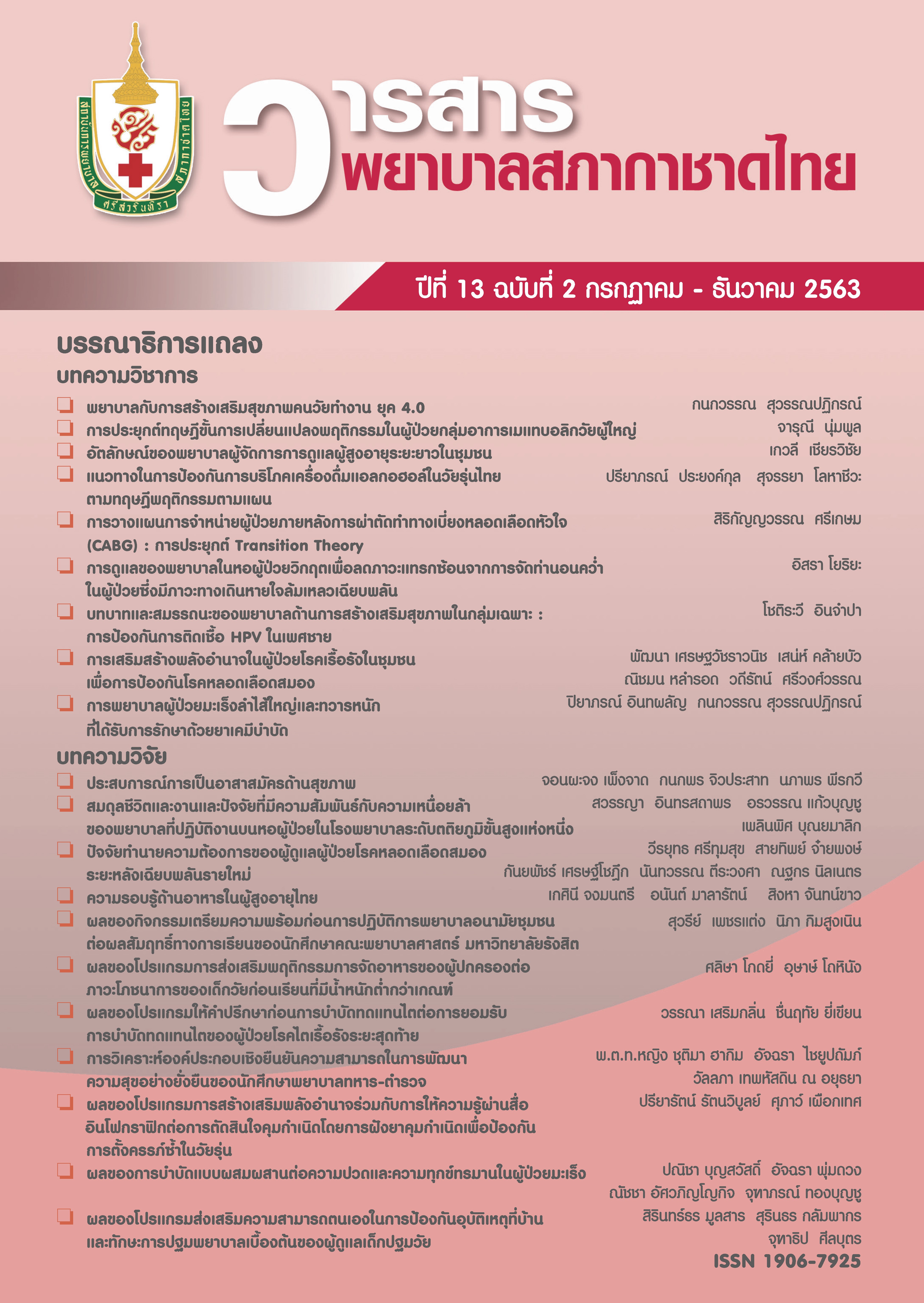Critical Care Nursing to Reduce Complications from Prone Position in ARDS Patients
Keywords:
critical care nurses, prone position, caring of prone position, ARDSAbstract
Acute respiratory distress syndrome (ARDS) is a syndrome that causes injury to the lungs, resulting in severe hypoxemia and a life threatening crisis in the respiratory system. Prone positioning is a supportive treatment that benefits to the patient by improving positive outcomes such as improved oxygenation and reduced mortality rates of patients with ARDS. Although the prone position has benefits, high risk complications such as airways-related complications, pressure ulcers, facial and ocular edema, dislodgement of catheters, hemodynamic instability, bone fractures and nerve injury often arise with the prone position . The article discusses methods that critical care nurses can utilize for reducing risk of prone position in ARDS patients. Caring for an ARDS patient with prone position composes three phases 1) pre-prone positioning 2) prone positioning and 3) post-prone positioning. Critical care nurses must be trained to care appropriately for prone patients through proper nursing care practice.
References
2. Henderson WR, Chen L, Amato MB, Brochard LJ. Fifty years of research in ARDS. Respiratory mechanics in acute respiratory distress syndrome. Am J Respir Crit Care Med 2017;196(7):822-33.
3. Amin Z, Amanda AP, Mamudi CO. Benefit of the Application of New ARDS Criteria (Berlin) Compared to Old Criteria (AECC) in a Tertiary Hospital in a Developing Country. Indian Journal of Public Health Research & Development 2017;8(2):273-8.
4. Pham T, Rubenfeld GD. Fifty years of research in ARDS. The epidemiology of acute respiratory distress syndrome. Am J Respir Crit Care Med 2017;195(7):860-70.
5. Bellani G, Laffey JG, Pham T, Fan E, Brochard L, Esteban A, et al. Epidemiology, patterns of care, and mortality for patients with acute respiratory distress syndrome in intensive care units in 50 countries. JAMA 2016;315(8):788-800.
6. Fan E, Brodie D, Slutsky AS. Acute respiratory distress syndrome: advances in diagnosis and treatment. JAMA 2018;319(7):698-710.
7. Alessandri F, Pugliese F, Ranieri VM. The role of rescue therapies in the treatment of severe ARDS. Respir Care 2018;63(1):92-101.
8. Marini JJ, Josephs SA, Mechlin M, Hurford WE. Should early prone positioning be a standard of care in ARDS with refractory hypoxemia?. Respir Care 2018;61(6):818-29.
9. Drahnak DM, Custer N. Prone positioning of patients with acute respiratory distress syndrome. Crit Care Nurse 2015;35(6):29-37.
10. Papazian L, Aubron C, Brochard L, Chiche JD, Combes A, Dreyfuss D, et al. Formal guidelines: management of acute respiratory distress syndrome. Ann Intensive Care 2019;9(1):69. doi: 10.1186/s13613-019-0540-9.
11. Guerin C, Beuret P, Constantin JM, Bellani G, Garcia-Olivares P, Roca O, et al. A prospective international observational prevalence study on prone positioning of ARDS patients: the APRONET (ARDS Prone Position Network) study. Intensive Care Med 2018;44(1):22-37.
12. Chadwick JR. Prone positioning in trauma patients: nursing roles and responsibilities. J Trauma Nurs 2010;17(4):201-7.
13. Henderson WR, Griesdale D, Dominelli P, Ronco. Does prone positioning improve oxygenation and reduce mortality in patients with acute respiratory distress syndrome?. Can Respir J 2014;21(4):213-5.
14. Senecal P. Prone position for acute respiratory distress syndrome. Crit Care Nurse 2015;35(4):72-4.
15. Oliveira VM, Piekala DM, Deponti GN, Batista DC, Minossi SD, Chisté M, et al. Safe prone checklist: construction and implementation of a tool for performing the prone maneuver. Rev Bras Ter Intensiva 2017;29(2):131-41.
16. Songmuang J. Nursing care for acute respiratory distress syndrome patients. Siriraj Med Bull 2017;10(3):174-9.
17. McKenna CG, Meehan C. Prone positioning in ARDS. Am Nurse Today 2018;13(12):39-41.
18. Ball C, Adams J, Boyce S, Robinson P. Clinical guidelines for the use of the prone position in acute respiratory distress syndrome. Intensive Crit Care Nurs 2001;17(2):94-104.
19. Munshi L, Del Sorbo L, Adhikari NK, Hodgson CL, Wunsch H, Meade MO, et al. Prone position for acute respiratory distress syndrome. A systematic review and meta-analysis. Ann Am Thorac Soc 2017;14(Suppl 4):s280-8.
Downloads
Published
Issue
Section
License
เนื้อหาบทความหรือข้อคิดเห็นต่างๆ ในวารสารพยาบาลสภากาชาดไทยนี้ เป็นความคิดเห็นของผู้เขียนบทความ ไม่ใช่ความเห็นของกองบรรณาธิการ หรือสถาบันการพยาบาลศรีสวรินทิรา สภากาชาดไทย






